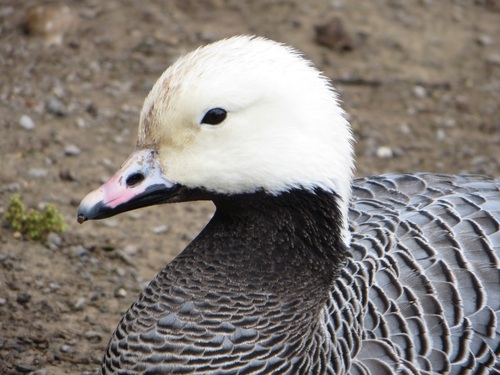
Emperor Goose
The Emperor Goose (*Anser canagicus*) is a striking waterfowl species native to the subarctic regions of Alaska and northeastern Siberia. It is notable for its beautiful blue-gray plumage, contrasting white head and neck, and bright orange legs. Unlike many other goose species, the Emperor Goose has a relatively restricted range and is less migratory. Ecologically, it plays a role in the coastal tundra ecosystems, grazing on vegetation and serving as prey for larger predators. While not currently considered globally threatened, its specialized habitat and limited range make it vulnerable to environmental changes.
66-89 cm
Length
119-140 cm
Wingspan
Near Threatened
Conservation Status
Distribution
Primarily breeds along the coastal regions of western Alaska (Yukon-Kuskokwim Delta) and northeastern Siberia (Chukotka Peninsula). Winters along the Aleutian Islands, the Alaska Peninsula, and the Kodiak Archipelago. Limited migration compared to other goose species.
Lifespan
Up to 15 years in the wild, potentially longer in captivity.
Emperor Goose's Habitat
Habitat Types
Coastal tundra, Salt marshes, Mudflats, Estuaries
Climate Zones
Subarctic, Arctic
Adaptations
Dense down feathers provide insulation against cold temperatures. Their salt glands, located near the eyes, allow them to excrete excess salt, enabling them to drink saltwater.
Variations
No recognized subspecies.
Appearance
Breeding Plumage
Adults have a distinctive blue-gray body plumage with black and white barring, giving a scaled appearance. The head and back of the neck are white, often stained orange from feeding in iron-rich waters. The bill is pinkish, and the legs and feet are bright orange. Juveniles have a duller gray-brown plumage and lack the distinct white head.
Seasonal Feather Changes
No significant seasonal variation in plumage, besides normal feather wear and tear.
Sex Based Plumage Differences
Minimal sexual dimorphism; males and females have very similar plumage.
Notable Features
Distinctive white head and neck contrasting with blue-gray body., Bright orange legs and feet., Scaled appearance of body plumage due to black and white barring.
Diet and Feeding
Primary Foods
Grasses, Sedges, Berries, Aquatic plants, Small invertebrates (during breeding season)
Foraging Behavior
Primarily grazes on vegetation in coastal tundra and salt marshes. Also dabbles in shallow water for aquatic plants and invertebrates.
Specializations
Serrated edges on their bill help them efficiently graze on grasses and sedges.
Seasonal Diet Variations
Diet shifts slightly depending on the season. During the breeding season, they consume more invertebrates to meet the protein needs of growing goslings. In winter, they rely more on grasses, sedges, and berries.
Behavior
Social Structure
Forms family groups during the breeding season. Outside of the breeding season, they often gather in larger flocks, particularly during molting and migration.
Communication
A variety of honking and cackling calls., Visual displays, such as head-bobbing and wing-flapping.
Migration
Relatively short-distance migrations between breeding and wintering grounds. Some populations may be largely resident.
Territorial or Group Behaviors
Territorial during the breeding season, defending nesting sites. Forms flocks during the non-breeding season for protection and foraging efficiency.
Conservation
Threats
Habitat loss and degradation due to climate change (sea-level rise, coastal erosion), Oil spills and other pollution, Hunting pressure (subsistence hunting), Disturbance from human activities, Predation (especially of eggs and goslings)
Protection Programs
Migratory Bird Treaty Act (protection in the US), Monitoring programs to track population trends
Local National Laws
Protected under the Migratory Bird Treaty Act in the United States and similar legislation in Russia.
Population Trend
Decreasing
Population Estimates
Estimated at around 80,000-90,000 individuals (as of recent assessments).
Interesting Facts
They are one of the least studied goose species in North America.
Their remote breeding grounds and relatively small population size make them difficult to study.
The orange staining on their head and neck comes from iron oxide in the mud.
This occurs when they feed in iron-rich waters.
Their scientific name, *Anser canagicus*, is derived from the Latin word for goose.
*Anser* is the Latin word for goose.
Faqs about Emperor Goose
Are Emperor Geese endangered?
They are currently classified as Near Threatened by the IUCN. While not immediately endangered, their population is declining, and they face several threats.
Where can I see Emperor Geese?
The best places to see Emperor Geese are in western Alaska (Yukon-Kuskokwim Delta), the Aleutian Islands, and the Alaska Peninsula during the breeding and wintering seasons. They are also found in northeastern Siberia.
Do Emperor Geese migrate long distances?
Compared to many other goose species, Emperor Geese have relatively short migrations. They primarily move between their breeding grounds in western Alaska and northeastern Siberia and their wintering grounds along the Aleutian Islands and the Alaska Peninsula.
What do Emperor Geese Sound Like?
Emperor Geese have loud, distinct, deep calls that are often described as a resonant "kla-ha, kla-ha, kla-ha."
Copyright @ Nature Style Limited. All Rights Reserved.
 English
English